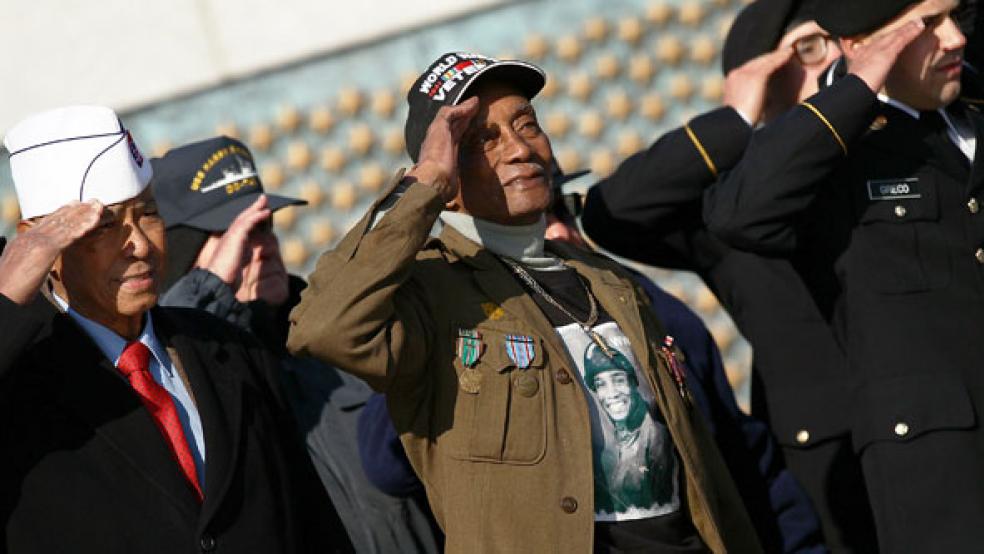Donald Trump went a step closer to transforming the way the Department of Veterans Affairs delivers healthcare this week by sending an aide to brief reporters on a plan that could allow vets eligible for care at VA facilities to seek care from a private physician. That doctor or hospital would be reimbursed by the federal government in a program much like Medicare.
The President-elect spent considerable time and energy on the campaign trail bad-mouthing the VA system for what he described as disgraceful treatment of ailing veterans, including long wait times, poor service, and questionable care. Speaking to the Veterans of Foreign Wars convention in July, he said, “The VA scandals that have occurred are widespread and inexcusable.” He said they constituted “a permanent stain on this government.”
Related: Two Years After VA Scandal, Healthcare System Still Stacked Against Vets
On Wednesday, an aide outlined to reporters the plan under consideration to allow vets to seek care outside the VA system, saying there is “definitely an option on the table to have a system where potentially vets can choose either or, or all private.”
However, it seems as though the idea -- not something that originated with the Trump administration -- isn’t quite fully baked yet. Among the questions being pondered by the incoming administration, the aide said, are some pretty basic ones: “How would you implement a program that could get vets the ability to go to any hospital that they wanted to go to?” and “If you were in the VA or out of the VA, how would you set it up?”
The problem here is that team Trump may well be dedicating scarce resources to a problem that is well on its way to being solved.
The VA, to be sure, was a national embarrassment a few years ago. In 2014 a wave of revelations found administrators falsifying documents in order to create the impression that they were compliant with departmental requirements regarding wait times. Veterans died while waiting for care, and overworked doctors began leaving the system in droves.
Related: Facing $1 Billion in Cost Overruns, VA Hospital Execs Head for the Exits
However, that was before President Obama tapped Army veteran and former Proctor and Gamble chairman and CEO Robert McDonald to take over the system in an attempt to turn it around. McDonald stepped into the role of VA secretary in July 2014, and since then, according to two recent reports by outside groups, the results have been dramatic.
McDonald began by firing 14 of 17 top leaders in the system, replacing them with a combination of internal promotions, former high-ranking military officers, and private sector business executives. The mission, as McDonald described it, was to change the culture of the agency from a “rules-based” system to a “principles-based” system.
Critics of the VA often described a department in which employees hewed closely to a rigid system of rules, often to the detriment of patients, because they knew that following the rules would keep their jobs safe.
In a study of the VA updated this month, the Harvard Business Review cited a particularly egregious example:
The leadership team had to work through vestiges of VA’s rule-based past. For instance, in May 2015, an employee answering the phone at the Puget Sound VA in Seattle received a call from a veteran who had broken his foot, driven himself to the hospital’s entrance and needed help getting into the building. Stymied by rules like don’t abandon your post, and advise patients outside the hospital to call 911 for assistance, the employee refused to go to the veteran and advised him to hang up and call 911. Ultimately, a team of Seattle firefighters was dispatched to the hospital’s parking lot to help the veteran from his car to the emergency room — a distance of 10 feet. In a rules-based organization, employees lack the flexibility of discretion.
Related: How Bureaucratic Red Tape Could Give a Convicted VA Exec Her Job Back
However, according to the investigators from Harvard Business School, much has changed at the VA since McDonald took over.
“Although the transformation remains ongoing, they have made considerable progress after two and a half years: Pending claims at VA have fallen by more than 90 percent; VA health care now performs better than the private sector on 96 percent of outpatient measures, according to RAND; and by the end of the year, all VA hospitals will offer same-day access to care, relative to none in 2014. In a survey conducted last month, 75 percent of veterans reported that VA effectively delivers care and services, up from 65 percent just a year ago.”
What’s more, the improvement in care has led to veterans signing up for VA Care at record numbers -- to the point, Harvard noted, that wait times are on the rise again, this time due to demand, not inefficiency.
These don’t appear to be hallmarks of an organization in need of a massive shake-up but rather of one that had already endured the shake-up and is now showing marked improvement. The positive changes raise the question of whether the incoming administration should be considering a major privatization push at this point in the VA’s renaissance.
If you ask veterans’ groups now, the answer is obvious: No.
Trump transition team members met with a number of veterans groups at the American Legion’s headquarters in Washington early this month. Afterward, the Legion’s executive director, Vera Jones, told Military.com that none of the groups were in favor of privatization.
“The American Legion absolutely opposes privatization,” she said. “We strongly advocate for a healthy VA health care system for veterans.”





